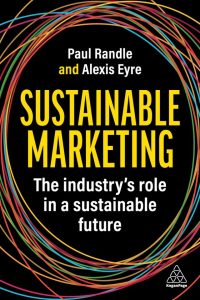The one-sentence summary
Marketing has a lot to answer for and needs to completely overhaul its approach to sustainability.
Can’t be bothered to read it? Listen to the 5-minute summary in two parts.
Want to buy the book? CLICK HERE
WHAT THE BOOK SAYS 
- This book is subtitled The industry’s role in a sustainable future. It begins by exposing the disturbing reality of marketing’s current relationship with many of our environmental and social problems. It challenges marketing’s traditional role, its cultural norms, and inefficiencies, and then suggests a vision for changing the industry into a force for good. The idea is to help marketing and sustainability professionals to work through sustainability transformation whilst avoiding the pitfalls of greenwashing and carbon myopia.
- The roll call of shaming information includes:
- Waste: Every second, a rubbish truck load of disused clothing is burnt or sent to landfill.
- Food. The food system is responsible for 90% of deforestation, with 38% dedicated solely to grazing animals. Every year the average household throws away 74kg of food.
- Biodiversity. We have lost 69% of wildlife populations in the last 50 years.
- Water. 2.1 billion people, over a quarter of the world’s population, do not have access to clean, safe drinking water.
- Consumption. In 2022, 5 billion mobile phones were thrown away. Nearly 80% of all products bought on Black Friday end up as waste within a year, often having been used only a handful of times.
- Inequality. The Global North contains only a quarter of the world population but houses 80% of the world’s wealth, so the level of impact per capita is exponentially higher than in the south.
- Plastic. 90% of it, worth $80-120 billion per year, is only used once before being discarded. Plastic bottles remain in the environment for as long as 450 years before they completely biodegrade.
- Clothing. The industry contributes a global carbon footprint of 2-10% of all carbon emissions, ranking fourth behind housing, transport and food.
- Pollution. 99% of the world’s population regularly breathes in polluted air with 8 million dying from exposure to fumes every year.
- Deforestation. 3 billion trees are cut down every year to produce paper and cardboard packaging, much of which is only used once before being thrown away.
- Events. Structures worth half a million dollars created for the 2020 Cannes Lions event were thrown into landfill after the event was over. Only 21% of promotional merchandise handed out is kept for any length of time, with a further 23% thrown away on the day it was given out, and most of the merchandise distributed at events goes to landfill within one month.
- Media content. 48% of all content created has little or no relevance to customers. 70-80% of display advertising has no attention paid to it at all and the average click through rate for search marketing is 6.3%. 30% of all media budgets, equating to $7.2 million, were subject to digital fraud in 2020.
- Overall, marketing suffers from very low trust, creative stagnation, system complexity, skill shortages, fraudulent and criminal behaviour, and questionable performance figures.
- 60 years of post-war marketing has consistently put it out of step with sustainability challenges. Global adspend is now an eye-watering $738 billion.
- People are subjected to 4,000 – 10,000 media impressions a day, and lack of trust in advertising is currently at its lowest ever – 16%. By depicting lifestyles, relationships or bodies, advertising is proven to make people unhappy.
- One source suggests that 74% of the marketing community now believe that marketing is incompatible with a sustainable future.
- To resolve this, the authors propose a Compass model that embeds sustainability at the heart of marketing practice, and three missions for the industry to improve its approach to the environment, society and commercialism.
WHAT’S INTERESTING ABOUT IT
- Carbon insetting refers to businesses removing emissions from within their own supply chains, making them more nature positive.
- Greenwashing was effectively born in 1961 when Monsanto produced a contradictory denial to a book highlighting the disastrous effects of DDT on the environment.
- The modern environmental movement started in the 1960s but the global recession of the 70s diverted attention from it and onto economic growth. It took until 1988 to get the issue back on the public agenda.
- The richest 1% of the world’s population have pocketed $26 trillion in new wealth since 2020, nearly twice as much as the other 99%.
- The Stockholm Resilience Centre has recreated the flat periodic table style of the United Nations Sustainable Development Goals into an ‘SDG Wedding Cake.’ In their opinion, a healthy biosphere holds the key to a healthy society, which creates a healthy economy, and the way to achieve this is through the large-scale impact of partnerships.
WHAT YOU HAVE TO WATCH
- You certainly need to be involved in marketing to find the book relevant, and probably require at least an inkling that marketing has a lot wrong with it. You then have a choice whether to leave the industry, as many have, or remain and try to improve things from within.
